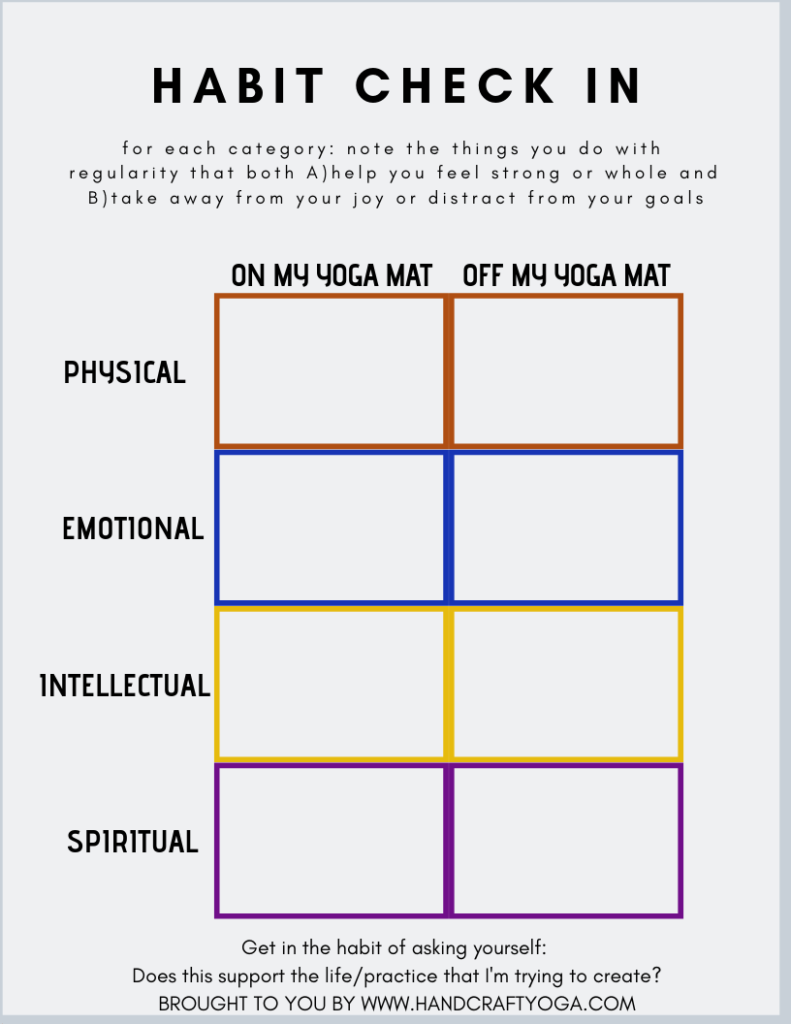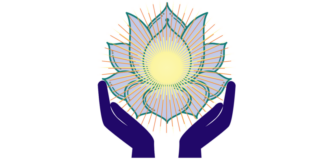habits, patterns, & tendencies, oh my!
It’s the beginning of spring, and change is in the air. We have certain expectations of the natural world, in the plants and their colors. Likewise, we have certain expectations in our own little worlds, in the plans and goals that we’ve set for the year. Therefor it’s (always) a good time to check in and ask ourselves: Are we providing the right resources? …and at the right intervals? Do the things we do regularly actually add value to my life? Do these plan(t)s actually stand a chance to bear the juicy fruit we long to sink our teeth into? Let’s take a look at Hand Craft Yoga’s Seasonal Habit Check In to find out!
types of habits & their influences
Moving away from the typical approach of bad vs good habits, we start by examining 4 categories: Physical, Emotional, Intellectual, and Spiritual. Each of these parts of ourselves has the potential to be quite habitual, with tendencies to behave or react in certain ways. Here are some examples:
Physical: exercise habits, hygiene habits, consumption habits
Emotional: default reactions to situations, the way we communicate internally/externally
Intellectual: how we learn and process, how we let ourselves be right/wrong
Spiritual: how we cultivate connection, patterns of belief/disbelief
Each of these types hosts many categories of our conditioning. Whether it was over the course of years in a certain type of household, or as a result of a traumatic incident, we all have potential to be locked into a certain way of being. It should be noted that whether we recognize it or not, this conditioning occurs daily at a subconscious level. Patterns are being formed and consequences are taking shape, without our even trying! Just like if we were to walk the same path thru a field each day, a groove would begin to form. That groove would appear to be the only way at times, and it becomes the default path. However, just because we always park in the same spot at the gym or always take the same route to work, doesn’t mean we can’t be open to seeing a different way.
Let’s look at an example story…
continuing with the commuting example…
You drive the same way to work each day. But this morning, you were distracted thanks to your new morning exercise routine! It took longer than expected and set you behind schedule. When you realized you’d be late, you stay cool because you know your boss is understanding. As you hurriedly set off, you’re a little distracted by these new… what did they call them? Exercise endorphins? Consequently you missed the normal turn, initially causing a stress response ($&#*!). You quickly remember the city grid and know this next street should get you back over where you need to be (rerouting!). With trust in your memory (and a hint of belief that things will work), you confidently blaze this new trail. Along the way, you spot an amazing array of wildflowers! Score! Despite your tardiness, you arrive at work beaming with excitement. You share the location with all of your coworkers, and as a result many people are inspired.
What a beauty full way to start the day! I know that was an ideal scenario story with the understanding boss and all, but for the sake of our exercise, just go with it. In that example alone, we can identify a few habits that led to this being a great morning instead of a stressful one. Let’s take a closer look at the various patterns present:
Physical: daily driving path, morning exercise
Emotional: flexible/understanding of circumstance, keeps cool, shares joy
Intellectual: awareness of surroundings, trust of memory, applications of knowledge
Spiritual: belief in things working, appreciation of nature
notice our own habits
I was tempted to create an unfavorable rendition of this example (wherein the “you” is perhaps less flexible to an alternate path), but decided that the comparison might create too much…well, comparison. Who am I (or anyone else for that matter) to say what is the best “way” for you to be? So a disclaimer here is that only you can label your tendencies as good, bad, or neutral. It is up to each of us on our individual journeys to discover these things about ourselves. But if we can become aware of our patterns and observe them, we might notice how they have influenced us over time. In addition, we might notice if that influence is creating a positive ripple effect, or a not so positive one? We can ask ourselves…Does this thing I do regularly make me feel strong and whole, or does it make me feel weak and distracted?
Ideally this process empowers us to actively choose which patterns to propagate and which are no longer serving us. This greater perspective could hopefully give us permission to free ourselves from repeating behaviors that cause us unhappiness or suffering. Then we can use our insights to change (or maybe intensify) certain habitual behaviors as needed in order to maximize our potential to transform. You might be thinking, whoa lady, I am not looking to transform today. Just trying to learn how to drink more water, thanks…but just hear me out.
It does not matter what you are trying to do. In order to make any new thing happen, there is a degree of transformation (#change) that needs to take place in either our attitude, behavior, physical body, or a combination, before a significant shift occurs. But in order to notice if it’s working, we have to know where we are starting. That is why it is essential to this process that we tap into our current tendencies. It is the key to hacking our system (even if the only thing we are looking to change is our water levels)! For that reason, I am offering this handy dandy Seasonal Habit Check In:

work it out:
This Seasonal Habit Check In is the worksheet I offered at the Yoga Sanctuary’s March Playshop. We weaved this theme into our yoga practice as well, which is why you see the two columns. Perhaps you practice yoga and this speaks to you. Great! If not, simply replace with any other hobby/sport/intention that you could apply this deeper self learning to.
It is important to work thru this sheet with a healthy dose of self love and compassion. Try not to be too hard on yourself, but remain true to your best interest. In other words, also try not to be too easy on yourself. We are capable of doing both. To read more about cultivating self love, please check out this post from last month or dive really deep and view the february workshop series!). Please notice at the bottom of the worksheet, I leave you with a challenge to incorporate a new habit into your arsenal of mental resources:
Get in the habit of asking yourself:
Does this support the life that I’m trying to create?
-clever pinterest posts
This simple question might prompt you to move away from the “same old, same old” and reveal a story you haven’t heard before!
Speaking of stories you haven’t heard before…my friend Katie & I discuss this topic on the new podcast: Write Here, Right Now (check out episodes 7-10!). In each episode of the podcast, we play with a creative writing exercise (that we invite you to participate in!) to help us rewire our tendencies and make space for possibility. Catch yourself off guard…listen to the podcast!
let’s get in the habit of connecting!
Please feel free to email me with input or questions towards this discussion or about the Seasonal Habit Check In! What kind of habits are you finding serve you best? How are you tapping into that deeper observation? Share your comment below… maybe you’ll inspire a fellow reader.
Speaking of readers, thank you for being one. It is a fantastic and fortunate habit to have.
